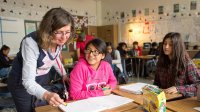Selecting Instructional Strategies That Students Can Master
Choosing a small number of strategies that students can use across content areas can help them focus on the concepts they’re learning.
Your content has been saved!
Go to My Saved Content.When teachers prepare lessons, they often incorporate new strategies—graphic organizers, mnemonics, charts, word banks, written outlines, and other materials—in the hope that variety will attract and hold student interest. Novelty can, however, have a negative impact on learning as students may spend more time trying to figure out how to use the strategy than on the concepts and big ideas they should be learning. And with so many different options to learn, students may not practice the strategy enough to use it independently of the teacher.
To help select which strategies to use as the mainstays of instruction, teachers should consider the following questions:
- How can students use the strategy across disciplines?
- How does the strategy engage students as active participants in their learning?
- How can students use the strategy independently of the teacher?
- Is the strategy flexible enough to be used in all learning environments?
Below are three examples of instructional strategies that can have a big impact on student learning.
1. Cognitive Routines
These are simple criteria or questions that students use repeatedly when approaching tasks with similar thinking demand. Students can employ learning targets and success criteria as a cognitive routine as shown by the following example:
“I can summarize information by doing the following:
- Determining what is most important,
- Being specific and to the point, and
- Saying it in my own words.”
These three steps serve as a mini-checklist for students when a teacher asks them to summarize, regardless of the content—the cognitive routine remains the same. When students repeatedly draw upon the strategy, it becomes a habit for learning. They’re in charge of when and how they use the method. Students can summarize independently or collaboratively. When students write a collective summary, they must work to come to a consensus on each of the criteria. Cognitive routines are easily transferable to any learning environment or modality, and students can summarize verbally or use paper or a whiteboard application.
2. Visual Routines
Visual routines are similar to cognitive routines but rely on a visual representation. Each image is explicitly linked to a thinking demand, making it applicable across disciplines. For example, students can use a tree map to sort and classify information in social studies—the economic, political, or social impact of specific events in history. In science, students can use a tree map to classify the characteristics of different types of matter.
The Thinking Map is different from a graphic organizer in that students are taught when and why to use Thinking Maps. Students learn how to create the maps on their own, which enables them to be able to readily use the strategy when completing a task. When working in remote or hybrid environments, students can easily create thinking maps on whiteboard applications.
3. Discussion Protocols
Discussion protocols like think-pair-share and the Text-Rendering Experience provide students with simple structures for conversation that can be used in all content areas. Think-pair-share, for example, is a simple way for students to make sense of information and carefully consider ideas before sharing with the class. In a remote or hybrid setting, student partners can discuss with each other in breakout rooms and then share in a chat box, whiteboard, or shared document so their thinking is captured for others to see. In math, think-pair-share provides a simple structure for students to solve problems and share the process they used. Students can then review class responses to look for trends and patterns in their thinking or ask clarifying questions to deepen their understanding.
The Text-Rendering Experience asks students to select a sentence, phrase, and word from a text for discussion. They then work in small groups to discuss what they selected and why and how it reflects the author’s message.
Once students become familiar with these or other simple protocols, they can easily move into conversations and focus on the question, ideas, or text rather than on the structure of the discussion.
When teachers select instructional strategies that actively engage students and develop those methods as routines for student learning, they’re equipping students with strategies for approaching the new and unknown. Using the suggestions in this post, teachers can begin by evaluating the methods they already use in their classrooms. With carefully selected instructional strategies, students will spend less time figuring out how to accomplish a task and more time focusing on the learning.
